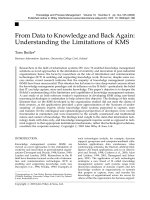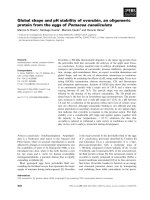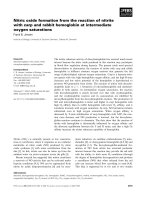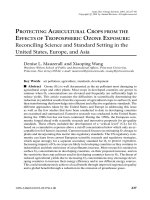Manufacturing and Environmental Management from the Standpoint of Management of Technology
Bạn đang xem bản rút gọn của tài liệu. Xem và tải ngay bản đầy đủ của tài liệu tại đây (902.06 KB, 5 trang )
10/2/2012
Manufacturing and Environmental Management from the
Standpoint of Management of Technology
JSPS Asian CORE Program Seminar (S‐2)
Sustainable Manufacturing and Environmental Management
October 6, 2012
研究拠点機関:名古屋大学
(研究基地学校名)
Hanoi, Vietnam
相手国(地域)・機関:
(合作国家(地区) ・学校名)
Soemon Takakuwa
中国:北京大学
北京大学
Nagoya University
Coordinator
(協力)天津大学、北京理工大学、西南交通大学
日本学術振興会
●
Asian CORE Program: Schematic Drawing
北京大学(中国)
300
Manufacturing and Environmental Management
北京理工大学(中国)
清華大学(中国)
対外経済貿易大学(中国)
●
<Manufacturing> ●
●
陝西師範大学(中国)
●
西南交通大学(中国)
Joint research
忠南大学(韓国)
天津大学(中国)
南開大学(中国)
●
北海道大学
◎
●
東京大学
復旦大学(中国)
神戸大学
<Teleconference>
名古屋大学(日本)
京都大学
大阪市立大学
<Workshop>
<Environment>
● ●
250
Other contries
UK
200
Canada
Germany
150
India
Japan
p
100
Russia
China
50
America
海南大学(中国)
ベトナム国家大学(ベトナム)
<Seminar/Symposium>
1973
1980
1985
1990
1995
2000
2005
2006
(Source: The Institute of Energy Economics, Japan)
参加機関
南洋理工大学(シンガ
ポール)
0
1971
Change of CO2 Emission in the World
拠点機関・協力機関
●
CO2 emission (exccluding fuel for vessels and aircrafts)
モンゴル国立大学
(モンゴル)
100
250
Technology
(230)
6%
75
Industry
7%
Transportation
Transportation 63
200
91
Industry
Agriculture
Industry
(77)
36%
14%
14
150
Advanced
agriculture
(26)
50
Hunting
Primitive (5)
(2)
2
3
4
4
7
Discovering
fire
Fire and
livestock
energy
66
Household
Service
32
18%
12
4
6
Bar graph:
Energy
100,000 5000 1000 1A.D. 1000
consumption
1,000,000
per capital
(1000 kal)
Household
25
24
1
Early
agriculture
(12)
7
1600 1700
Charcoal, water wheel,
windmill, horsepower
energy
1800
Food 10
1900
Coal
Curved line: world's
energy consumption
In terms of oil (1 million
barrels/days)
Service
19%
Energy
transformation
Others
Oil
Change of Energy Consumption
Breakdown of the source of CO2 Emission in Japan (as of 2007)
(Source: Ministry of Environmnent (MOT), Japan – modified)
(source: “Annual Report on the Environment, the Sound Material-Cycle Society and the Biodiversity in Japan ” MOE Japan)
1
10/2/2012
Implementation framework of
research and educational plans
Climate change and energy/resources
Manufacturing and environmental management in east Asia
○The manufacturing industry in the Chubu Region (the central region of Japan) dominates
in the world.
○The east Asian countries have been achieving remarkable economic growth.
○The environmental and the resources problems have been highlighted.
○ The bases of
manufacturing
shifting to the east
A i countries
Asian
ti
Recent trends
○Introducing Japanese management of
manufacturing to manufacturers in the east Asian
countries
○The destruction of the environment
○Government, industry, and the citizens circles
coping with environmental problems in each
country
○Ex-students at Japanese universities being active
in the various fields in the east Asian countries
○Indispensable
relationship between
manufacturing and
environment
The necessities of the collaboration:
○To promote both research and education together with the institutions in the east Asian countries for
finding the solutions to the Asian-wide problems.
○To produce teaching materials of manufacturing and environmental management, and to increase
the awareness of the environment for students through education
Sustainable society
Drastically reduce
greenhouse gas
emissions
Achieve sustainable economic
growth and development
while remaining in harmony
with the global ecosystem
Reduce, reuse, and
recycle resources
(3Rs)
Recycling‐
oriented society
Low‐carbon
society
Climate change and ecosystems
Ecosystems and environmental burden
Environmentally‐friendly society
Enable people to enjoy the rich
abundance of nature for generations
to come
Source: Leading Environmental Nation Strategy in the 21st Century –Japan’s Strategy for a Sustainable Society (approved by the Cabinet June 1, 2007)
Socio‐environmental management
–from Management Point of View‐
1. Sustainable development
The integration of its economic, environmental and social
components at all levels.
2. Extended producer responsibility (ERP)
An environmental policy approach in which a producer’s
responsibility for a product is extended to the post‐
consumer stage of a product’s life cycle. ( OECD )
3. Environmental management
Decrease in the burden on the environment from business
activities
Global Environmental Issues
Air Pollution
Offensive odor
FACTORY
Soil contamination caused
by dumping waste illegally
PRIVATE HOUSE
Discharge to small
river or sewers
Noise
OFFICE
Vibration
Discharge to soil
Discharge to the water source
(river, pond/lake, ocean)
Pollution; Manufacturing and Environmental Problems
Groundwater pollution
Recycling-oriented society
(Source: Ministry of Environmnent (MOT), Japan – modified)
(source:Dr. Ibusuki (JEMAI))
2
10/2/2012
Factory Location Law
Port and Harbor
Law
Building
Standards Law
Air Pollution Control
Law
Waste Disposal and
Public Cleaning Law
Offensive Odor Control Law
Water Pollution
Control Law
Noise Regulation Law
<Outline of Environmental Regulation on Factories>
Vibration Regulation Law
Framework of environmental law
(Source: Ministry of Environment (MOT), Japan – modified)
Source: Ministry of Economy, Trade and Industry (MEIT), Japan
Create
Environmental initiatives must be carried out by a full spectrum of socioeconomic actors
(particularly by the small‐ and medium‐sized institutions that form the backbone of Japan’s
industry)
Proactive environmental initiatives are carried out, including efforts to boost energy efficiency,
conserve natural resources, and reduce waste in the course of business activities and offer more
environmentally‐friendly products and services
Energy Conservation Law, Japan
Source: Ministry of Economy, Trade and Industry (MEIT), Japan
Environmental management systems are
required to help companies promote and
manage environmental initiatives that are
efficient, effective, and ongoing
Requires environmental communication:
companies that are properly carrying out
initiatives must fulfill their social obligation to
explain these activities and have them
evaluated by society
Environmental management systems that are
easy for a broad range of companies and
organizations to adopt
Environmental activity reports (environmental
reports) that are easy for a broad range of
companies and organizations to create
EcoAction 21 Guidelines
Purpose and overview of EcoAction 21
Example
business
activities
Identification of
environmental
burden (self‐check)
Environment
al initiatives
(self‐check)
Use of fossil fuels in air
conditioning systems or
boilers
Greenhouse gas (CO2) emissions
Electricity purchased, incineration
of fossil fuels, waste oil, waste
plastics, etc.
Restrict CO2 emissions
Waste generated at shops
or during the production
process
Waste generated
Business waste, industrial waste,
etc.
Restrict waste disposal,
recycle
Water drained from
Water drained from
plants or other facilities
Total water drainage
Total
water drainage
Discharge into sewers or public
waters
Effluent treatment
Effluent treatment
Water consumption
during manufacturing
processes
Water usage
City waters, industrial waters,
groundwater, etc.
Conserve water, use water
more efficiently
Chemical substances used
in products as raw
materials or during the
manufacturing
process(e.g. during
washing or coating)
Chemical substances usage
Substances covered by the PRTR
program
Restrict and manage
chemical substance usage
(source: EcoAction 21 Japan)
Quiz
I have a car; its fuel consumption is 10 km/l. Suppose
that I drive my car with my friend to go to a city where
the distance is 100 km away from here.
How much would CO2 emissions be expected to go to
the city one way per one person?
(Hints)
‐ Specific gravity of gasoline is 0.75.
‐ Weight of carbon contained in 1 kg of gasoline is 0.85 kg.
‐ Atomic weight of carbon (C) and oxygen (O) are 12 and 16, respectively.
Business activities and environmental burden items (source: EcoAction 21 Japan)
3
10/2/2012
Sample Environmental Efficiency Indicators
Production output or net sales volume (yen)
CO2 emissions (tons)
Value added
Waste generated (tons)
Waste
generated (tons)
Value added
CO2 emissions (tons)
Value added: (1) subtracting the cost of materials and other inputs (outside
purchases) from net sales volume, or (2) adding operating profit, labor
costs, and depreciation expenses.
(Source: Ministry of Environment, Environmental Reporting Guidelines 2007.)
(source: EcoAction 21 Japan)
Environmental Accounting:
Combining Environmental and Economic Activities
as a Basic Tool for Environmental Management
“from the cradle to the grave”
Environmental Management Accounting:
Specialized in internal management of a company
For reports to executives and managers
For reports to executives and managers
Used for internal management of a company
(e.g. Material Flow Cost Accounting)
External Environmental Accounting:
Specialized in external reporting
For reports to external stakeholders
(corporate evaluation, etc.)
Manufacturing Activities
Social Cost
(Source: EMA Workbook, METI, Japan)
Comprehensive Management of Technology
(Source: Japan Society of P.E.)
4
10/2/2012
JSPS Asian CORE Program Seminar
年度
セミナー番号
実施日
場所
S-1
2008年10月04日~05日
Peking University, CHINA
S-2
2008年12月26日~28日
Nagoya University, JAPAN
S-3
2009年3月27日~29日
Beijing Institute of Technology, CHINA
S-1
2009年9月24日~25日
Marco Polo Parkside Hotel, CHINA
S-2
2009年11月21日~23日
Nagoya University, JAPAN
Management of Manufacturing and
Technology in East Asia (Part 1)
S-3
2010年1月04日~06日
Hainan University, CHINA
Management of Manufacturing and
Technology in East Asia (Part 2)
S-1
2010年5月05日~08日
Nankai University, CHINA
Manufacturing and Technology
Management in East Asia (Part 1)
S-2
2010年5月29日~06月03日
Fudan University, Shaanxi Normal
University, CHINA
S-3
2010年10月17日
Nagoya University, JAPAN
2008年度
2009年度
2010年度
セミナー/シンポジウム テーマ
International Seminar on Environmental
Cooperation between China and Japan
International Seminar on Manufacturing
Management and Environmental
Management
International Seminar on ICT,
Manufacturing Management and
Environmental Management
International Seminar on Low-Carbon
Economy
Toward to Low-carbon Economic
Development in Asia
Building a Low-Carbon Society:
Environment Management and
International Cooperation
S-4
2010年12月21-22日
nabyang Technological Univdrsity,
SINGAPORE
Low-Carbon Economy and Manufacturing
in Asia
S-5
2011年1月29-30日
Nagoya University, JAPAN
Manufacturing and Environmental
Management
S-1
2011年10月20-22日
Chungnam National University, KOREA
Manufacturing and Environmental
Management in East Asia
S-2
2012年1月20-21日
Meiji University, JAPAN
Manufacturing and Environmental
Management under Low-carbon Society
2011年度
Major Books
published or to be published by FY2012
1. 「低炭素経済学」(日)
「低碳经济学」(中) 社会科学文献出版社
「Low‐carbon Economics」(英)
2. 「東アジアにおける技術マネジメント」(日)中央経済社
「东亚地区的生产与技术管理」(中) 科学出版社
3. 「モノづくりと環境のマネジメント」(日) 中央経済社
「Manufacturing and Environmental Management」(英)Vietnam National
University Press
Full Papers with acknowledgments for JSPS Asian CORE program: 120+
Manufacturing and Environmental Management
Contents
Chapter 1 Manufacturing and Environmental Management from the Standpoint of Management of Technology
1 Manufacturing and Environmental Problems
2 Environmental Management from the standpoint of Management of Technology
3 Some Approaches to Environmental Problems
Chapter 2 Environmental Problems and Environmental Policies in Japan
1 JEMAI Activities for Supporting Environmental Management in Industry, Responding to Industrial Pollution
to Global Warming
2 Environmental Policies and Environmental Business in Japan
Chapter 3 Management of Energy Conservation and EC Law
Chapter 4 Management of Chemical Substances
1 SAICM and the Challenge of Chemicals Management
2 Voluntary Management of VOC Emission Control at Monodzukuri Cleaning Processes –Application of
EVABAT in VOC Risk Management
3 Management Corresponding to RoHS in Home Electrical Appliances
Chapter 5 Manufacturing and Life Cycle Assessment
Chapter 6 Some Approaches to Reduction of Environmental Loading in Logistics and Supply Chain
1 Green Logistics Policies in Japan
2 Designs and Challenges in Closed-Loop and Low Carbon Supply Chains for Sustainability
Chapter 7 Environmental Management System
1 The Outline of ISO14000 Series
2 Japan’s EcoAction 21 Guideline, and Certification and Registration
Chapter 8 Material Flow Cost Accounting
1 Significance and International Standardization of Material Flow Cost Accounting
2 Introduction of Material Flow Cost Accounting into the supply chain
Chapter 9 Voluntary Action Plans of Japan’s Industries on a Low Carbon Society
1 Nippon Keidanren Voluntary Action Plan on the Environment and a Low Carbon Society
2 Action Plan of The Industries of Electrical and Electronic on a Low Carbon Society
Chapter 10 Environmental Management
1 Toyota Environment Actions
2 JICA’s Efforts in Environmental Management in East Asia
3 Corporate Manufacturing and Environmental Management: Examples of Industry-Academia-Government
Alliances, and Collaboration with NPOs
5









